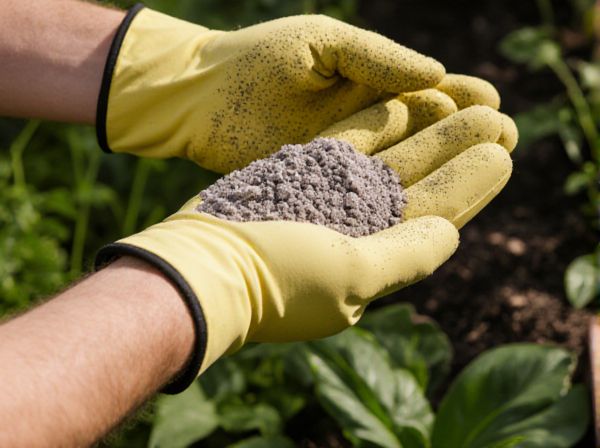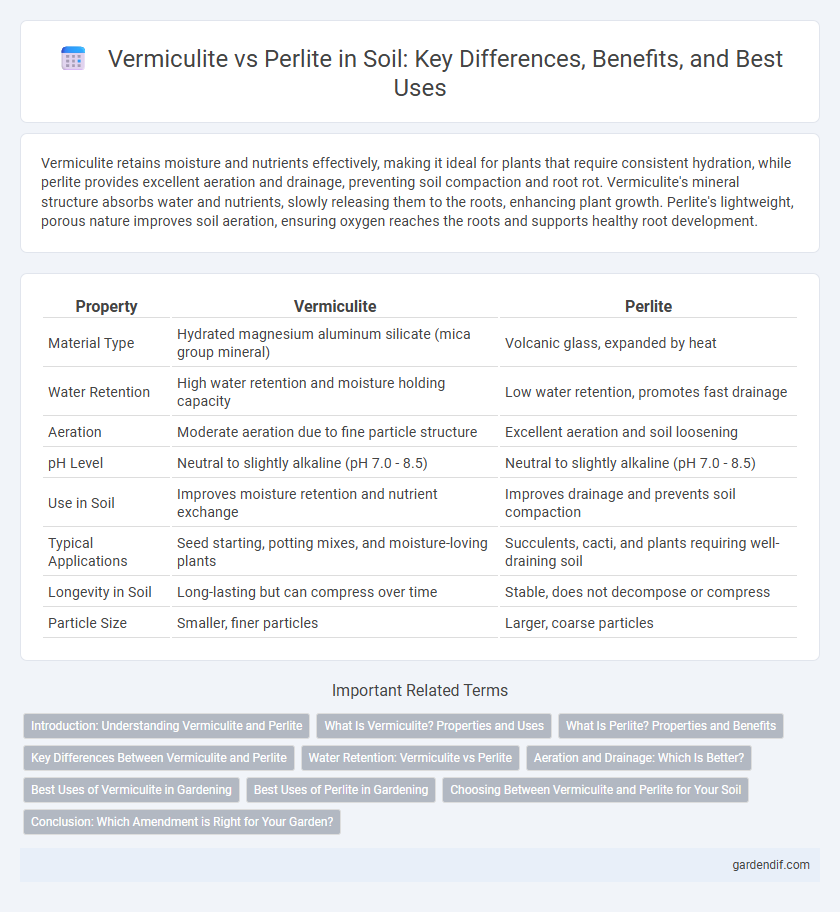
Vermiculite vs Perlite Illustration
Vermiculite retains moisture and nutrients effectively, making it ideal for plants that require consistent hydration, while perlite provides excellent aeration and drainage, preventing soil compaction and root rot. Vermiculite's mineral structure absorbs water and nutrients, slowly releasing them to the roots, enhancing plant growth. Perlite's lightweight, porous nature improves soil aeration, ensuring oxygen reaches the roots and supports healthy root development.
Table of Comparison
| Property | Vermiculite | Perlite |
|---|---|---|
| Material Type | Hydrated magnesium aluminum silicate (mica group mineral) | Volcanic glass, expanded by heat |
| Water Retention | High water retention and moisture holding capacity | Low water retention, promotes fast drainage |
| Aeration | Moderate aeration due to fine particle structure | Excellent aeration and soil loosening |
| pH Level | Neutral to slightly alkaline (pH 7.0 - 8.5) | Neutral to slightly alkaline (pH 7.0 - 8.5) |
| Use in Soil | Improves moisture retention and nutrient exchange | Improves drainage and prevents soil compaction |
| Typical Applications | Seed starting, potting mixes, and moisture-loving plants | Succulents, cacti, and plants requiring well-draining soil |
| Longevity in Soil | Long-lasting but can compress over time | Stable, does not decompose or compress |
| Particle Size | Smaller, finer particles | Larger, coarse particles |
Introduction: Understanding Vermiculite and Perlite
Vermiculite is a hydrous phyllosilicate mineral known for its excellent water retention and aeration properties, commonly used in soil conditioning and seed starting. Perlite, a volcanic glass that expands when heated, provides superior drainage and aeration in potting mixes. Both minerals enhance soil structure but serve distinct roles based on moisture retention and aeration needs.
What Is Vermiculite? Properties and Uses
Vermiculite is a hydrated magnesium aluminum silicate mineral known for its excellent water retention, aeration, and insulating properties, making it ideal for soil amendment. Its lightweight, spongy texture allows it to absorb and hold moisture while improving soil structure and nutrient exchange. Commonly used in gardening, vermiculite enhances seed germination, root growth, and moisture management in potting mixes and hydroponic systems.
What Is Perlite? Properties and Benefits
Perlite is a volcanic glass that expands when heated, creating a lightweight, porous material commonly used in soil mixes to improve aeration and drainage. Its high water retention capability helps maintain moisture levels while preventing root rot, making it ideal for seed starting and container gardening. Perlite's sterile and pH-neutral properties reduce the risk of disease and provide a stable growing medium for various plants.
Key Differences Between Vermiculite and Perlite
Vermiculite is a mineral that expands when heated, providing excellent moisture retention and nutrient-holding capacity, making it ideal for water-loving plants and seed starting. Perlite is a volcanic glass that also expands when heated, offering superior aeration and drainage due to its lightweight, porous structure that prevents soil compaction. The key differences between vermiculite and perlite lie in their water retention abilities and aeration properties, with vermiculite retaining more moisture and nutrients, while perlite enhances soil aeration and drainage.
Water Retention: Vermiculite vs Perlite
Vermiculite holds significantly more water than perlite due to its layered, absorbent structure, making it ideal for moisture-loving plants. Perlite has a porous, granular composition that promotes excellent drainage and aeration but retains less water. Gardeners often choose vermiculite for water retention and perlite for improving soil aeration and preventing compaction.
Aeration and Drainage: Which Is Better?
Vermiculite retains moisture while providing moderate aeration, making it ideal for water-loving plants but less effective for rapid drainage. Perlite offers superior aeration and excellent drainage due to its porous structure, preventing soil compaction and root rot. For optimal soil aeration and drainage, perlite is generally preferred, especially in container gardening and seedlings.
Best Uses of Vermiculite in Gardening
Vermiculite is ideal for seed starting, soil aeration, and moisture retention due to its high water-holding capacity and lightweight structure. It enhances nutrient absorption and promotes healthy root development in container gardening and raised beds. Compared to perlite, vermiculite retains more water, making it especially beneficial for plants requiring consistent moisture levels.
Best Uses of Perlite in Gardening
Perlite is best used in gardening for improving soil aeration and drainage, making it ideal for container plants, seed starting, and hydroponics. Its lightweight, porous structure helps retain moisture while preventing soil compaction, promoting healthy root growth. Perlite's neutral pH and sterility make it suitable for mixing with potting soil to enhance plant health and growth.
Choosing Between Vermiculite and Perlite for Your Soil
Vermiculite enhances soil aeration and water retention, making it ideal for moisture-loving plants and seed starting, while perlite improves drainage and prevents soil compaction, suited for succulents and cacti. Both amendments are lightweight and sterile, but vermiculite's finer texture aids nutrient retention, whereas perlite's porous structure boosts oxygen flow to roots. Selecting between vermiculite and perlite depends on your plant type and soil moisture needs to optimize growth conditions effectively.
Conclusion: Which Amendment is Right for Your Garden?
Choosing between vermiculite and perlite depends on your soil needs: vermiculite excels in moisture retention and nutrient absorption, ideal for seed starting and moisture-loving plants, while perlite provides superior aeration and drainage, perfect for succulents and heavy clay soils. Gardeners seeking improved water retention and cation exchange capacity should opt for vermiculite, whereas those needing enhanced soil structure and oxygen flow benefit more from perlite. Evaluating your garden's water needs and soil texture ensures the right amendment supports optimal plant growth and health.
Vermiculite vs Perlite Infographic

 gardendif.com
gardendif.com